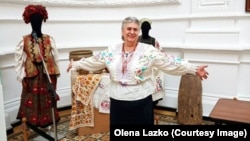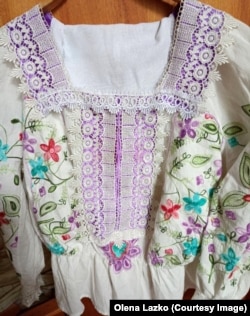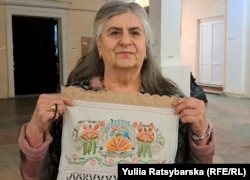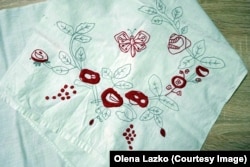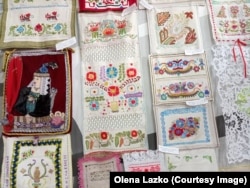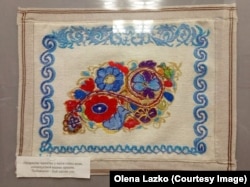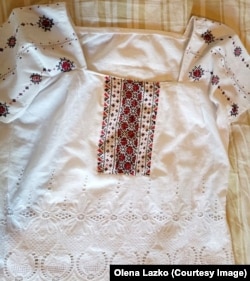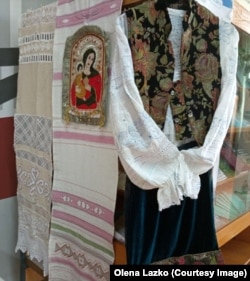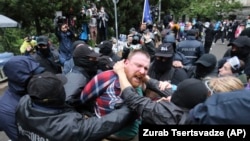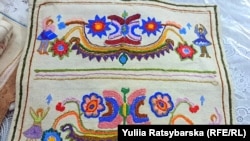
As Ukrainians worldwide celebrate Vyshyvanka Day on May 16, one woman who was forced to flee her home has made its celebration particularly poignant.
Olena Lazko and her family were forced to flee their home after shelling upended their lives. One of the items she took was a precious, handcrafted embroidery nearly 100 years old that was given to her by an elderly neighbor.
Passion For Embroidery
Lazko, 73, hails from the small village of Velika Novosilka, some 50 kilometers from Donetsk in southeastern Ukraine. She was born into a family of teachers. After receiving degrees in history and psychology, she worked at a school for 40 years before her retirement. From the first time she sat down at the sewing machine at the age of 6, she has had a deep love for needlework.
In 1973, during her studies in Donetsk, Lazko began her research into traditional Ukrainian embroidery.
"I went to the library to learn about traditional types of Slavic clothing. The people there looked at me like I was crazy. Unlike now, there was not a lot of information, and if there was, it was forgotten."
Though interested in needlework and ethnography, Lazko was unable to pursue her interests until after she retired, when she joined a group of knitters, embroiderers, and masters of decoupage. Initially, she had an interest in using natural materials to create installations, but eventually she turned to embroidery.
Lazko also studied Greek embroidery. "Our village is unique. It is the only one that was founded by two Greek communities, the Urums and the Rumeis. I recreate Greek embroidery based on samples collected from local women and photos from museums," she said, though she was not entirely happy with her results.
"I looked critically at my work and thought, what is this? A dust cloth? I'm not Parajanov! That's why I focus on household items. For example, napkins that have a purpose," she said.
To further her education, Lazko visited libraries and museums throughout Ukraine. However, it was with the help of the Internet and online portals such as the Metropolitan Museum that her knowledge really expanded.
The Russian Invasion Of Ukraine
In March 2022, the village where Lazko and her family -- husband, daughter, and grandchildren -- lived came under fire. Though their house survived, those of her neighbors did not.
Village life was irretrievably altered when its House of Culture, library, and museum burned down. In addition, the village's gas, electricity, water supplies, and communications were destroyed, cutting it off from the outside world.
Lazko remembers how the remaining villagers had gathered around a bonfire, using whatever ingredients they could find, to make borscht. She also recalls how on that Easter, she made Paskha, a traditional Slavic dish, on the street in a frying pan.
"The fuel had already run out before Easter when I started preparing Paskha's at home. I dug up the last stumps in the barn and made a fire in the street where I fried them in a pan," she said before adding, "I shared it with the old people in the village who were hungry."
One of her neighbors, the nearly blind 86-year-old Nina, who survived the Holodomor -- the 1932-33 starvation of millions in Ukraine under Soviet leader Joseph Stalin, lived next door in a house whose widows had been blown out by the shelling.
"I brought her water, soup, croutons -- whatever," Lazko said. She also recalls how 'grandmother Nina' would carefully ration her food. "I would come by and ask her, "What did you drink or eat today?" and she would answer, "Cocktail!" The concoction was well water combined with rainwater that she collected.
Lazko continued to bring her tea and what food she could.
She also recalls how Nina inscribed on the gate to her home the inscription "people" to let others know that someone lived there. Nina also hung a white handkerchief from the door. After looking closely at Nina's "rag," she realized that it was an embroidered handkerchief from nearly a century ago.
Though made in the 1930s, the fabric featuring flowers -- representing the souls of born and unborn children -- was still in good condition. "The work is plain, but the semantics can be understood," Lazko said.
She recalls asking Nina if she could keep it in hopes that one day the village museum, which had burned to the ground, would reopen and the memento could take its rightful place. Nina agreed, and three weeks later, as she was taken away by her relatives, she fulfilled her promise.
Lazko and her family were evacuated from the village on August 9, 2022. Along with two kittens and a dog, the most priceless items she took with her were Nina's handkerchief and her embroidered creations.
Life And Creativity After The Evacuation
Since resettling in Dnipro, a major industrial city in southeastern Ukraine, Lazko has had six personal exhibitions in local libraries and museums featuring her embroidery. The handkerchief that Nina gave her is now at the Museum of Resistance to the Holodomor in Dnipro.
"For the whole three-month winter season, the second floor of the Art Museum housed 50 of my pieces. The paintings filled two hallways; they were framed and displayed under glass, adjacent to the masterpieces by Petrykiv painting masters," she said.
"In addition, there were my paintings with Greek and Ukrainian motifs. I gave the Yavornytskiy House Museum a panel titled Flowers Of The Steppe last week. Yavornytskiy loved dried flowers, steppe grasses, and flowers. In Dnipro, the museum staff and librarians are now all my friends, my social circle."
On the eve of Vyshyvanka Day, Lazko was busy finishing an embroidered shirt for her 20-year-old granddaughter.
"My granddaughter is not only a patriot; she also tries to find an opportunity to proudly say that she is a Ukrainian every minute of her life. This is why these shirts are very important (to us)," she said.




